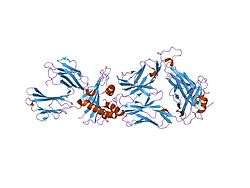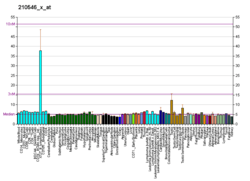| CTAG1B |
|---|
 |
| Available structures |
|---|
| PDB | Human UniProt search: PDBe RCSB |
|---|
| List of PDB id codes |
|---|
1S9W, 2BNQ, 2BNR, 2F53, 2F54, 2P5E, 2P5W, 2PYE, 3GJF, 3HAE, 3KLA |
|
|
| Identifiers |
|---|
| Aliases | CTAG1B, CT6.1, CTAG, CTAG1, ESO1, LAGE-2, LAGE2B, NY-ESO-1, cancer/testis antigen 1B |
|---|
| External IDs | HomoloGene: 133254 GeneCards: CTAG1B |
|---|
|
|
| Orthologs |
|---|
| Species | Human | Mouse |
|---|
| Entrez | | |
|---|
| Ensembl | | |
|---|
| UniProt | | |
|---|
| RefSeq (mRNA) | | |
|---|
| RefSeq (protein) | | |
|---|
| Location (UCSC) | Chr X: 154.62 – 154.62 Mb | n/a |
|---|
| PubMed search | [2] | n/a |
|---|
| Wikidata |
|
Cancer/testis antigen 1 is a protein that in humans is encoded by the CTAG1B gene.[3][4][5]
It is a tumor antigen.
References
- 1 2 3 GRCh38: Ensembl release 89: ENSG00000184033 - Ensembl, May 2017
- ↑ "Human PubMed Reference:".
- ↑ Chen YT, Boyer AD, Viars CS, Tsang S, Old LJ, Arden KC (Jun 1998). "Genomic cloning and localization of CTAG, a gene encoding an autoimmunogenic cancer-testis antigen NY-ESO-1, to human chromosome Xq28". Cytogenet Cell Genet. 79 (3–4): 237–40. doi:10.1159/000134734. PMID 9605863.
- ↑ Aradhya S, Bardaro T, Galgoczy P, Yamagata T, Esposito T, Patlan H, Ciccodicola A, Munnich A, Kenwrick S, Platzer M, D'Urso M, Nelson DL (Nov 2001). "Multiple pathogenic and benign genomic rearrangements occur at a 35 kb duplication involving the NEMO and LAGE2 genes". Hum Mol Genet. 10 (22): 2557–67. doi:10.1093/hmg/10.22.2557. PMID 11709543.
- ↑ "Entrez Gene: CTAG1B cancer/testis antigen 1B".
Further reading
- Scanlan MJ, Gure AO, Jungbluth AA, et al. (2003). "Cancer/testis antigens: an expanding family of targets for cancer immunotherapy". Immunol. Rev. 188: 22–32. doi:10.1034/j.1600-065X.2002.18803.x. PMID 12445278.
- Chen YT, Scanlan MJ, Sahin U, et al. (1997). "A testicular antigen aberrantly expressed in human cancers detected by autologous antibody screening". Proc. Natl. Acad. Sci. U.S.A. 94 (5): 1914–8. doi:10.1073/pnas.94.5.1914. PMC 20017. PMID 9050879.
- Lethé B, Lucas S, Michaux L, et al. (1998). "LAGE-1, a new gene with tumor specificity". Int. J. Cancer. 76 (6): 903–8. doi:10.1002/(SICI)1097-0215(19980610)76:6<903::AID-IJC22>3.0.CO;2-1. PMID 9626360.
- Wang RF, Johnston SL, Zeng G, et al. (1998). "A breast and melanoma-shared tumor antigen: T cell responses to antigenic peptides translated from different open reading frames". J. Immunol. 161 (7): 3598–606. PMID 9759882.
- De Smet C, Lurquin C, Lethé B, et al. (1999). "DNA methylation is the primary silencing mechanism for a set of germ line- and tumor-specific genes with a CpG-rich promoter". Mol. Cell. Biol. 19 (11): 7327–35. PMC 84726. PMID 10523621.
- Schultz-Thater E, Noppen C, Gudat F, et al. (2000). "NY-ESO-1 tumour associated antigen is a cytoplasmic protein detectable by specific monoclonal antibodies in cell lines and clinical specimens". Br. J. Cancer. 83 (2): 204–8. doi:10.1054/bjoc.2000.1251. PMC 2363487. PMID 10901371.
- Rimoldi D, Rubio-Godoy V, Dutoit V, et al. (2001). "Efficient simultaneous presentation of NY-ESO-1/LAGE-1 primary and nonprimary open reading frame-derived CTL epitopes in melanoma". J. Immunol. 165 (12): 7253–61. doi:10.4049/jimmunol.165.12.7253. PMID 11120859.
- Simpson JC, Wellenreuther R, Poustka A, et al. (2001). "Systematic subcellular localization of novel proteins identified by large-scale cDNA sequencing". EMBO Rep. 1 (3): 287–92. doi:10.1093/embo-reports/kvd058. PMC 1083732. PMID 11256614.
- Jungbluth AA, Chen YT, Stockert E, et al. (2001). "Immunohistochemical analysis of NY-ESO-1 antigen expression in normal and malignant human tissues". Int. J. Cancer. 92 (6): 856–60. doi:10.1002/ijc.1282. PMID 11351307.
- Goydos JS, Patel M, Shih W (2001). "NY-ESO-1 and CTp11 expression may correlate with stage of progression in melanoma". J. Surg. Res. 98 (2): 76–80. doi:10.1006/jsre.2001.6148. PMID 11397121.
- Zarour HM, Maillere B, Brusic V, et al. (2002). "NY-ESO-1 119-143 is a promiscuous major histocompatibility complex class II T-helper epitope recognized by Th1- and Th2-type tumor-reactive CD4+ T cells". Cancer Res. 62 (1): 213–8. PMID 11782380.
- Satie AP, Rajpert-De Meyts E, Spagnoli GC, et al. (2002). "The cancer-testis gene, NY-ESO-1, is expressed in normal fetal and adult testes and in spermatocytic seminomas and testicular carcinoma in situ". Lab. Invest. 82 (6): 775–80. doi:10.1097/01.lab.0000017169.26718.5f. PMID 12065688.
- Nagata Y, Ono S, Matsuo M, et al. (2002). "Differential presentation of a soluble exogenous tumor antigen, NY-ESO-1, by distinct human dendritic cell populations". Proc. Natl. Acad. Sci. U.S.A. 99 (16): 10629–34. doi:10.1073/pnas.112331099. PMC 124995. PMID 12138174.
- Resnick MB, Sabo E, Kondratev S, et al. (2002). "Cancer-testis antigen expression in uterine malignancies with an emphasis on carcinosarcomas and papillary serous carcinomas". Int. J. Cancer. 101 (2): 190–5. doi:10.1002/ijc.10585. PMID 12209997.
- Peng LP, Liu HY, Ran YL, et al. (2003). "[Expression of NY-ESO-1 gene in human esophageal carcinoma and its cloning]". Ai Zheng. 21 (5): 469–72. PMID 12452034.
- Strausberg RL, Feingold EA, Grouse LH, et al. (2003). "Generation and initial analysis of more than 15,000 full-length human and mouse cDNA sequences". Proc. Natl. Acad. Sci. U.S.A. 99 (26): 16899–903. doi:10.1073/pnas.242603899. PMC 139241. PMID 12477932.
- Gnjatic S, Atanackovic D, Jäger E, et al. (2003). "Survey of naturally occurring CD4+ T cell responses against NY-ESO-1 in cancer patients: correlation with antibody responses". Proc. Natl. Acad. Sci. U.S.A. 100 (15): 8862–7. doi:10.1073/pnas.1133324100. PMC 166404. PMID 12853579.





